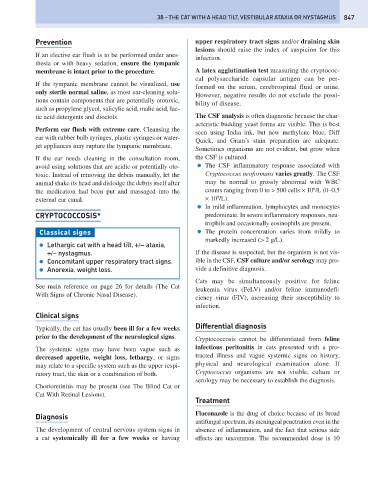Page 855 - Problem-Based Feline Medicine
P. 855
38 – THE CAT WITH A HEAD TILT, VESTIBULAR ATAXIA OR NYSTAGMUS 847
Prevention upper respiratory tract signs and/or draining skin
lesions should raise the index of suspicion for this
If an elective ear flush is to be performed under anes-
infection.
thesia or with heavy sedation, ensure the tympanic
membrane is intact prior to the procedure. A latex agglutination test measuring the cryptococ-
cal polysaccharide capsular antigen can be per-
If the tympanic membrane cannot be visualized, use
formed on the serum, cerebrospinal fluid or urine.
only sterile normal saline, as most ear-cleaning solu-
However, negative results do not exclude the possi-
tions contain components that are potentially ototoxic,
bility of disease.
such as propylene glycol, salicylic acid, malic acid, lac-
tic acid detergents and dioctols. The CSF analysis is often diagnostic because the char-
acteristic budding yeast forms are visible. This is best
Perform ear flush with extreme care. Cleansing the
seen using India ink, but new methylene blue, Diff
ear with rubber bulb syringes, plastic syringes or water-
Quick, and Gram’s stain preparation are adequate.
jet appliances may rupture the tympanic membrane.
Sometimes organisms are not evident, but grow when
If the ear needs cleaning in the consultation room, the CSF is cultured.
avoid using solutions that are acidic or potentially oto- ● The CSF inflammatory response associated with
toxic. Instead of removing the debris manually, let the Cryptococcus neoformans varies greatly. The CSF
animal shake its head and dislodge the debris itself after may be normal to grossly abnormal with WBC
6
the medication had been put and massaged into the counts ranging from 0 to > 500 cells × 10 /L (0–0.5
9
external ear canal. × 10 /L).
● In mild inflammation, lymphocytes and monocytes
CRYPTOCOCCOSIS* predominate. In severe inflammatory responses, neu-
trophils and occasionally eosinophils are present.
Classical signs ● The protein concentration varies from mildly to
markedly increased (> 2 g/L).
● Lethargic cat with a head tilt, +/- ataxia,
+/- nystagmus. If the disease is suspected, but the organism is not vis-
● Concomitant upper respiratory tract signs. ible in the CSF, CSF culture and/or serology may pro-
● Anorexia, weight loss. vide a definitive diagnosis.
Cats may be simultaneously positive for feline
See main reference on page 26 for details (The Cat
leukemia virus (FeLV) and/or feline immunodefi-
With Signs of Chronic Nasal Disease).
ciency virus (FIV), increasing their susceptibility to
infection.
Clinical signs
Typically, the cat has usually been ill for a few weeks Differential diagnosis
prior to the development of the neurological signs. Cryptococcosis cannot be differentiated from feline
The systemic signs may have been vague such as infectious peritonitis in cats presented with a pro-
decreased appetite, weight loss, lethargy, or signs tracted illness and vague systemic signs on history,
may relate to a specific system such as the upper respi- physical and neurological examination alone. If
ratory tract, the skin or a combination of both. Cryptococcus organisms are not visible, culture or
serology may be necessary to establish the diagnosis.
Chorioretinitis may be present (see The Blind Cat or
Cat With Retinal Lesions).
Treatment
Fluconazole is the drug of choice because of its broad
Diagnosis
antifungal spectrum, its meningeal penetration even in the
The development of central nervous system signs in absence of inflammation, and the fact that serious side
a cat systemically ill for a few weeks or having effects are uncommon. The recommended dose is 10

